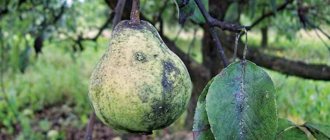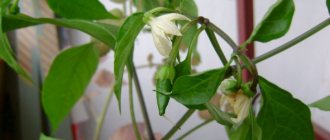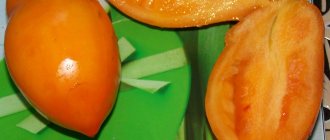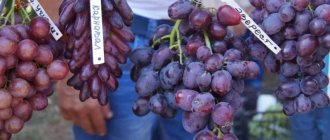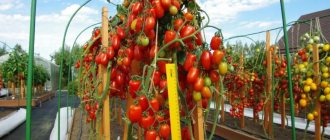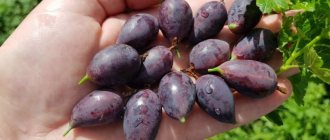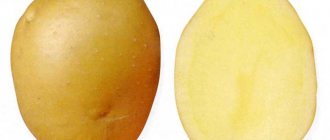Many gardeners cut sweet peppers from the bushes before they are fully ripe. This measure allows you to extend the shelf life of the vegetable, but often causes a deterioration in its taste. However, there are varieties that do not have this disadvantage. For example, Viking is tasty both at the stage of technical and biological ripeness. This article will familiarize the gardener with a description of the crop, its pros and cons, and the nuances of cultivation.
History of the variety's creation
Viking bell pepper was bred by Russian breeders at the end of the last century. The originator of this variety is the West Siberian Vegetable Experimental Station VNIIOO, this institution is located in the Altai Territory, Barnaul. She is also the applicant for the variety to be included in the State Register of Russia.
After breeding, the variety was presented for variety testing only in 2003; Viking bell peppers were tested in experimental plots for 3 years, and in 2006 it was entered into the State Register of Russia, assigned the number 9610492.
Viking pepper - photo
The variety is zoned for cultivation in the West Siberian, East Siberian and Far Eastern districts in film greenhouses and greenhouses, as well as in garden beds on private farms.
Characteristics and description of the variety
This variety of bell pepper is early ripening
– from the moment of germination of the seed to the harvesting of ripe Viking products, it takes from 4 to 4.5 months. And you can harvest fruits at the stage of technical ripeness already 110 days after the sprouts appear.
The bushes are medium-sized, not spreading, compact, so they can be grown in low greenhouses.
At the same time, up to 4 fruits are tied on one bush. The ripening of peppers is amicable.
Photo of Viking pepper
The ripe fruits of this pepper are large in size, prism-shaped, with an average weight of about 190 g, but with good care you can also harvest peppers weighing 260-300 g. Their walls are small in thickness (about 4.5 mm), the variety is not thick-walled is. The color of the fruit at the stage of technical ripeness is green; as the peppers fully ripen, they become rich red. Their walls are smooth, even and with a characteristic shine.
The taste of ripe Viking fruits is wonderful
. The pulp is compact, juicy, its aroma is light peppery, there is no characteristic bitterness in the taste. The fruits are not prone to cracking even during heat treatment.
The harvested crop is of universal use; the fruits are added to salads and snacks, used in canning - for making lecho and other twists.
Ripe fruits tolerate transportation well over different distances; they can be stored in appropriate conditions longer than fruits of other varieties of bell peppers.
Pepper Viking - video
Since Viking pepper is not a hybrid, but a variety, vegetable growers collect seeds from ripe fruits for further planting
. It should be remembered that the germination rate of seed material collected from the beds is not too high and lasts for no more than 3 seasons. But vegetable growers recommend using the seeds of this vegetable crop collected in the fall for planting next year.
Sweet pepper "Aconcagua"
This is a very large variety, named after the mountain in Argentina where it originates. Plants can grow up to 90 cm in height and often need staking as the fruits are abundant and heavy. In good conditions, the pod size can approach 30 cm in length and ripen from green to orange or red. The fruit tastes great for fresh consumption at any stage of ripeness and is great for roasting when fully ripe. Ripening period is 110-120 days.
Sweet pepper "Aconcagua". © Lyudmila Svetlitskaya
Sweet pepper "Aconcagua", bush. © Lyudmila Svetlitskaya
Sweet pepper "Aconcagua" in section. © Lyudmila Svetlitskaya
My review of Aconcagua pepper . I can’t say for sure whether the pepper I grew was the Aconcagua variety, but I bought it from a collector under that name. However, it grew suspiciously similar to the “Kappi Honey” variety described above. It had the same thick, low bushes, abundantly strewn with fruits. The lower fruits were so long that they even lay half on the ground. But still, I cannot characterize their length as outstanding, because they were not much longer than the “Kappi Honey” variety.
In the technical ripeness phase, the color of the fruit was somehow indistinct and the illusion arose that the peppers were made of wax. In the stage of biological ripeness, they became bright orange with a very slight red tint, but never acquired the rich red color as shown in the pictures. In general, they were suspiciously similar to the “Honey Cuppies” that grew next to them and were distinguished only by more pronounced ribbing, blunt tips and a brighter color. Therefore, I can’t say whether it was a mismatch or whether the peppers turned out that way in my conditions. In any case, in the photo of this pepper on the Western Internet, my “Aconcagua” was very similar.
Advantages
The main advantages of Viking bell pepper include:
- early fruit ripening;
- the possibility of growing in greenhouses and greenhouses in regions with harsh climatic conditions;
- high productivity;
- Almost all ripening peppers have an excellent presentation;
- for further sowing, you can collect seeds from ripened fruits of the Viking variety;
- the variety is resistant to temperature fluctuations.
This bell pepper has no particular disadvantages, but many vegetable growers say that the walls of the harvested fruits are too thin.
Sweet pepper "Friggitello pepperoni"
The famous variety of sweet pepper from Naples. Produces sweet, light green, medium-sized fruits 12 cm long and 3 cm wide. When ripe they become a bright cherry red color. Peppers have thick, sweet flesh and are highly prized in cooking. Peppers are great for grilling and can also be peeled and roasted whole. It grows into a fairly strong bushy plant. It prefers full sun and its dense foliage prevents sunburn.
Sweet pepper "Friggitello pepperoni". © Lyudmila Svetlitskaya
Sweet pepper "Friggitello pepperoni", bush. © Lyudmila Svetlitskaya
Sweet pepper "Friggitello pepperoni" in a section. © Lyudmila Svetlitskaya
My review of the Friggitello pepperoni. Its taste is delicate, sweetish and peppery. The wall is thin, approximately 3 mm, the length of the fruit is on average 15 cm. The bush is highly branched, 70 cm high, did not need a garter. The shape of the peppers was unusual - as if crumpled, often curved. Many fruits had a funny forked nose. The color of the pod is bright red. Productivity is average. Unfortunately, this variety was very affected by rot, although the summer was hot and dry. As a result, I lost half of his harvest.
Selecting a site for planting
When choosing a site for planting bell peppers, you should remember: this crop needs a place well lit by sunlight with fertile and loose soil.
You also need to follow the rules of crop rotation; the best predecessors for this vegetable crop are:
- onion;
- pumpkin;
- all varieties of cabbage;
- cucumbers
It can also be noted that good precursors for bell peppers are green manure, which improves the composition of the soil and is an excellent organic fertilizer.
You cannot grow peppers after potatoes, peppers and tomatoes. If it is not possible to grow peppers in a new place every year, then a large amount of organic matter is first added to the soil (up to 6-7 kg of humus or compost for each square of area).
Planting seedlings
It is better to grow this variety of bell pepper using seedlings.
. When planting purchased seeds, pre-sowing preparation is not required. But the seed material collected from your garden should first be kept for half an hour in a weak solution of potassium permanganate for disinfection, then placed briefly in a preparation to accelerate growth. Then you should wrap the seeds in a damp cloth for germination for 2-3 days.
It is better to purchase soil for planting Viking bell pepper seedlings in a specialized store - in this case, all the necessary fertilizers have already been added to it.
Important!
Seedlings are transplanted into open ground or a greenhouse at the age of 2 months. If the seedlings have outgrown, then they will not take root well in the new place and will get sick longer. As a result, the yield of such plants may decrease in the future.
Pepper seedlings have a very delicate root system that does not tolerate transplantation well - it takes a long time to take root in a new place, so experienced vegetable growers recommend immediately planting the seeds in separate peat cups, with which the grown seedlings are then transplanted to a permanent place in the garden or greenhouse.
While growing pepper seedlings, they should be fed at least 2 times.
. The seedlings are fed for the first time when they have at least 2 permanent leaves. Typically, urea or another preparation containing nitrogen is used as a fertilizer. The next feeding is carried out 12-14 days after the first, but no later than two weeks before transplanting the seedlings to a permanent place. As a fertilizer, you can use a solution of mullein diluted with water in a ratio of 1:10, or chicken manure diluted in a ratio of 1:15.
12-14 days before transplanting mature seedlings to a permanent place, they should begin to be hardened off. To do this, containers with plants are taken out into the fresh air for a short time at first, but the time the seedlings spend outside is gradually increased. In the last days before transplanting, the seedlings are left outside overnight.
Features of growing the variety
Pepper is a southern, heat-loving crop, but having reached the northern latitudes, it has “settled in”, but requires special attention.
Growing seedlings
If you are the owner of a heated greenhouse, then you can sow pepper seeds for seedlings in early March. In this case, backlighting is necessary. If there is no lighting, it is better to postpone sowing until the end of March.
Let's prepare the soil
In order for the seedling period to be successful, it is necessary to prepare in advance:
- planting soil;
- containers for sowing;
- a warm place for seeds to germinate;
- a cool, bright place to grow.
It is better to purchase seedling soil in the store. There are several reasons for this:
- Universal soil is balanced in nutrients;
- The soil is enriched with those microelements that are necessary specifically for seedlings;
- The mixture is tested for acidity, and its level is adjusted to the optimal ratio;
- Store-bought soils are prepared taking into account water and breathability;
- The soils have been tested for the presence of pathogenic microflora and treated with special preparations;
- The mixtures are ready for direct seed sowing.
If you trust yourself more, then the soil for sowing pepper seeds should consist of fresh compost, well-ripened humus and garden soil in a ratio of 1:1:1. To a bucket of this mixture add 1 kg of coarse sand, 1 kg of stove ash and 2 tbsp. spoons of superphosphate. It is advisable to prepare the soil mixture in the fall so that it has time to “ripen”. The mixture must be kept in a frost-free room. The soil microflora will process organic matter over the course of 5-6 months, and make the mineral components available for absorption by the young root system of seedlings.
Let's prepare the seed
If sowing with dry seed is practiced, then this should be done 2-3 weeks earlier than usual. In addition, if there is little seed and you are not sure of its germination, it is better to give preference to sowing with germination.
To germinate pepper seeds, simply place them in a flat container, on a damp cloth or moistened filter paper, wrap them in a plastic bag and send them to a place where the temperature will be maintained around the clock at 25-27 ᵒC. After 2-3 days, you need to remove the bag and sow on the ground only those seeds that have shown signs of life. Living and non-living seeds are easy to distinguish. Those that are suitable for sowing will be swollen and have a small white root, the rest will not show signs of life.
Sowing
Pepper seeds can be sown both in a common container and in individual cups.
If sowing is carried out in one container, then when the first pair of true leaves appear, the seedlings will need to be planted in individual cups.
May be interesting Formation of peppers in a greenhouse: how to form correctly Planting and growing cucumbers “Jolly guys f1” What are parthenocarpic cucumbers: varieties, growing features
General sowing is carried out as follows:
- the container is filled with soil mixture;
- compact;
- seeds are placed on top at a distance of 1.5-2 cm from each other;
- cover with soil with a 1-1.5 cm ball;
- slightly compacted;
- spray with warm water from a spray bottle;
- covered with glass or film;
- put in a warm place for germination.
Individual sowing is carried out in a similar way, but one seed is placed in one glass with a capacity of at least 200 ml.
Transplanting Viking pepper seedlings into open ground
The beds for transplanting bell pepper seedlings are prepared in advance. To do this, organic matter is added to the soil, all plant residues are removed, the soil is dug up and loosened.
How to properly plant peppers in open ground - video
Between adjacent planting holes, you need to make a distance in rows of about 0.4 m, and the row spacing should be up to 0.5 m.
Immediately before planting, 30 g of complex mineral fertilizer, necessarily containing potassium and phosphorus, is added to each hole.
After planting, the plants are watered and mulched with a layer of humus or straw.
Viking pepper care and further cultivation
In the future, regular watering should be carried out; it is necessary that the top layer of soil is constantly moistened, but without stagnation of water in the soil.
Interesting!
The best varieties of hot hot peppers for open ground and home cultivation.
It is also necessary to loosen the soil around the pepper bushes, at the same time remove all weeds and add mulch so that the moisture from the soil evaporates more slowly.
When planting seedlings, pegs are driven in next to the planting hole to which the plants need to be tied. The garter is needed so that the shoots do not break under the weight of the ripening crop.
To increase the yield of this variety, the first buds on the bushes must be removed - this is a feature of the Viking bell pepper.
And to prevent the fruits from acquiring bitter notes, this variety should not be planted next to hot peppers - the bushes are cross-pollinated, and all the fruits acquire a bitter taste.
Sweet pepper "Jimmy Nardello"
Pepper "Jimmy Nardello" is elongated, thin, curved in shape, with an average length of 12 to 25 cm. The skin is waxy, shiny and slightly wrinkled. As the fruits ripen, they gradually change color from green to bright red. Hidden beneath the thin skin is crisp, red-orange flesh enclosing a narrow cavity. Peppers have a mild, sweet and fruity flavor when fresh and contain virtually no heat.
Sweet pepper "Jimmy Nardello". © Lyudmila Svetlitskaya
Sweet pepper "Jimmy Nardello", bush. © Lyudmila Svetlitskaya
Cutaway sweet pepper "Jimmy Nardello" © Lyudmila Svetlitskaya
My review of the Jimmy Nardello pepper . This variety turned out to be my favorite last season among long-fruited peppers. First of all, it’s just incredibly early! Already on the 20th of June it was ready for harvesting, because in the technical ripeness phase it is quite tasty. This pepper stood covered with fruits when other varieties were just blooming. Secondly, this is the sweetest pepper I have ever tasted. It was just sweet, as if sprinkled with sugar. Thirdly, the variety showed simply dizzying productivity.
He also had absolutely no illnesses and had no blossom end rot. Fried in a frying pan, its taste was revealed even more, and ordinary pasta with such pepper turned into a restaurant dish. I usually try not to repeat myself in order to try other varieties of vegetables, but I will definitely plant this variety again.
Rules for feeding sweet peppers
This variety of bell pepper should be fed once every 12-14 days. At the same time, the application of mineral and organic fertilizers is alternated. Usually, in the summer, liquid fertilizers are applied under the roots, and care must be taken that their drops do not fall on the foliage and stems.
The first feeding of pepper bushes is carried out 12-14 days after transplanting the seedlings to a permanent place
. For this, 4 tbsp. l. ammonium nitrate is diluted in a bucket of water, and the resulting solution is watered under the plants.
Sweet pepper "Marconi purple"
This sweet and tasty Italian pepper is conical-shaped with a blunt tip and grows up to 15 cm in length. It has a sweet taste and crunchy texture, ideal for salads, but can also be used for frying, baking and stuffing. The color of the fruit changes as it ripens from green to dark purple, with sweetness appearing at the red-purple stage. Ripening period is 90-105 days. The height of the bush is 60-90 cm. There is also “Marconi yellow” and “Marconi red”.
Sweet pepper "Marconi purple". © abhege
Sweet pepper "Marconi purple", bush. © Lyudmila Svetlitskaya
Sweet pepper "Marconi red". © Lyudmila Svetlitskaya
My review of Marconi purple pepper . Although in the technical ripeness phase it has a truly fantastic, almost black color, during this period I did not like its taste at all and seemed grassy. But when the fruits became fully ripened and acquired a reddish-purple color, their taste changed for the better and became rich and sweet.
I find especially interesting the increased juiciness of this pepper and at the same time very crispy walls. Still, fresh Marconi peppers were not as good as when cooked. But to cook this pepper, you need to adapt.
My first attempt at baking Marconi peppers was unsuccessful. Due to its thinness, it bakes much faster than usual peppers, so I overcooked it in the oven. Now baked Marconi peppers, stuffed or unstuffed, are one of my favorite quick meals. Later I grew “Marconi” in other color variations - red and yellow, but I didn’t see much difference in these varieties other than color. I found purple particularly interesting because of the coloring.
Reviews from those who planted Viking peppers
Sveta, 44 years old, Moscow region: I bought this variety by accident, one might say - for change, purchasing seeds of various vegetable crops for further planting in the garden. It was written on the bag that the bushes do not grow large, but this variety grew almost 1 m in height. After flowering, I tied up all the Viking bushes so that the stems would not break off under the weight of the ripening fruits. I did not expect a big harvest, since the summer period was quite cool. However, despite the weather conditions, I reaped a large harvest from the bushes of this variety, even surprising myself.
Olga, 39 years old, Kirov region: I have been growing this variety of bell pepper for several seasons. I can say that its yield does not depend on weather conditions and is equally high both in hot weather and in cool rainy weather. We harvest in mid-August, and the fruits are tasty and have no bitterness. However, I recommend obligatory gartering of bushes in the spring, as well as fertilizing during the season.
The Viking bell pepper variety is perfect for growing in Siberia and the Urals, where it can be grown not only in open ground garden beds, but also in greenhouse conditions
. The variety is early ripening, so its fruits have time to ripen even in short, cool summer conditions.
Recently searched:
How to plant, grow and care
Like all other varieties of pepper, “Viking” has its own planting subtleties and nuances that you need to pay attention to when growing it. Let's look at these questions in more detail.
How to plant
The soil for planting Viking must be previously prepared. It is best to plant this crop after harvest:
This variety produces the greatest fertility when planted after green manure. Moreover, the latter can serve as an excellent option for future feeding for him.
Important ! This hybrid pepper variety should not be planted after potatoes, tomatoes or peppers. But, if there are no other places, then the land must be thoroughly fertilized with any organic matter.
How to grow
"Viking" is grown through seedlings. The beginning of its preparation is February. It is worth considering that this variety does not like transplanting, therefore, it is better to plant all the seeds in separate pots in advance.
Peppers can be transplanted to the place of permanent ripening 70 days after the appearance of the first shoots. Cultivation continues in greenhouse conditions or in open ground. But in order for the plant to receive the necessary amount of nutrients, the distance between the bushes should be 40 cm or more.
How to care
The basis for caring for Viking peppers is regular daily watering and fertilizing twice a month. Both mineral and organic fertilizers can be used as fertilizing. It is also necessary to systematically weed and loosen the soil.
It will be possible to collect fruits no earlier than July. At the same time, the plant will bear fruit until September.
Where is the best place to grow
Sweet pepper "Viking" produces the largest number of fruits in the southern regions of Russia if grown in a greenhouse. Good results can also be achieved when growing this variety in areas with moderate climatic conditions.
